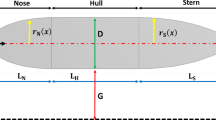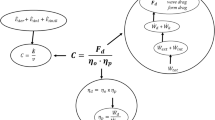Abstract
This paper proposes a study of the kinetics and dynamics of slalom waterskiing. The discipline of slalom waterskiing is first described. Then the forces applied on a “static” skier, i.e. just pulled behind a boat, are expressed as a function of water drag coefficients, speed and pitch angle. A slalom point model is finally proposed, made of three major contributions: water friction, water lift and an additional water drag contribution on the slalom skier, creating the traverse motions. Assumptions are made in order to quantify the three angles characterizing the ski position during the slalom traverses. The model is simulated on an EXCEL worksheet, for a large range of conditions (boat speed between 52 and 58 km/h, rope length between 18.25 and 13 m, and three skier masses of 60, 80 and 100 kg). The water friction coefficient was fitted to a value allowing to simulate successful slalom courses. The simulations provide a significant set of kinematics and dynamics parameters (skier velocity, acceleration, tangential force and rope tension). The model duly renders the variations of the skier velocity, and it reflects the increasing difficulty for the skier to complete the slalom at higher boat speed and shorter rope length.








Similar content being viewed by others
References
Lind, D., Sanders, S.: Skiing at the Triple Point. Springer, New York (1996)
Silverberg, L., Gardiner, J.: Simulation of the mechanics of waterskier motion. Math. Comput. Simul 34, 163–181 (1992)
Oboe, R., Antonello, R., Biral, F.: Development of a water ski simulator for indoor training with proprioceptive and visual feedback (2014). In: Proceedings AMC2014, Yokohama, Japan, March 14–16, 428–433
Savitsky, D.: Hydrodynamic design of planing hulls. Mar. Technol. 1(1), 71–96 (1964)
Murray, A.: The Hydrodynamics of planing Hulls, paper presented at the February 1950 Meeting of the New England Section of Society of Naval Architects and Marine Engineers (1950)
Faltinsen, O.: Hydrodynamics of High-Speed Marine Vehicles. Cambridge University Press, New York (2010)
Durey, A.: Physique pour les Sciences du Sport, (written in French), Ed. Masson, Paris (1997)
Runciman, J.: Waterskiing biomechanics: a study of intermediate skiers. J. Sports Eng. Technol. 225, 231–239 (2011)
Bray-Miners, J., Runciman, J., Monteith, G.: Water skiing biomechanics: a study of advanced skiers. Proc. IMechE, Part P J. Sports Eng. Technol. 227(2), 137–146 (2012)
Bray-Miners, J., Runciman, J., Groendyk, N.: Methods and instrumentation for the biomechanical analysis of slalom water skiing. Proc. IMechE, Part P. J. Sports Eng. Technol. 228, 75–85 (2014)
Bray-Miners, J., Runciman, J., Monteith, G., Groendyk, N.: Biomechanics of slalom water skiing. Proc. IMechE, Part P J. Sports Eng. Technol. 229, 47–57 (2015)
International Waterski and wakeboard Federation, Waterski Rules 2021, version 3, 22 (2021). http://www.iwsf.com
CKP-Engineering web site : https://www.ckp-engineering.fr
Acknowledgements
The author would like to thank M. Vincent Stadlbaur for providing the pictures supporting Figure 4a, b. The author would also like to thank Dr. Jordan Bray-Miners and Prof. John Runciman for the complementary information related to their study about the biomechanics of waterskiing. Finally the reviewers are acknowledged for their comments that allowed to improve the paper.
Funding
No funding was received to assist with the preparation of this manuscript.
Author information
Authors and Affiliations
Corresponding author
Ethics declarations
Conflict of interest
The author has no competing interests to declare that are relevant to the content of this article.
Additional information
Publisher's Note
Springer Nature remains neutral with regard to jurisdictional claims in published maps and institutional affiliations.
Rights and permissions
Springer Nature or its licensor (e.g. a society or other partner) holds exclusive rights to this article under a publishing agreement with the author(s) or other rightsholder(s); author self-archiving of the accepted manuscript version of this article is solely governed by the terms of such publishing agreement and applicable law.
About this article
Cite this article
Lance, B. Modelling of slalom waterskiing. Arch Appl Mech 94, 435–448 (2024). https://doi.org/10.1007/s00419-023-02526-w
Received:
Accepted:
Published:
Issue Date:
DOI: https://doi.org/10.1007/s00419-023-02526-w




